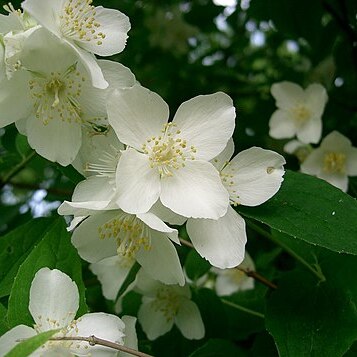Deciduous shrubs with slender, arching and occasionally scandent stems with close or sometimes flaking bark. Leaves opposite, entire or dentate, sessile or shortly petiolate, lower surface often pubescent with simple hairs, upper surface green and glabrous or with few scattered pili, usually with 3-5 prominent veins from base. Flowers white, showy, often fragrant, solitary or in few-flowered terminal cymes; hypanthium turbinate, united with the ovary, calyx-lobes 4, rarely 5-6; petals 4, rarely 5-6, obovate, rounded or retuse at apex, convolute in bud; stamens 20 or more, filaments flat, subulate, anthers small, oblong; ovary inferior to half superior, 4 or rarely 3 or 5 chambers, placentae axial, bearing numerous ovules; styles 3-5, filiform, more or less united, each bearing an elongate stigma; capsule turbinate, ligneous or coriaceous, 3-5 chambers, dehiscing loculicidally from the top; seeds numerous, oblong.
Shrubs erect, rarely climbing, rarely spinescent. Branchlets opposite. Leaves opposite, exstipulate, veins 3-5, basifugal, margin entire or serrate. Inflorescences racemose, paniculate, or cymose, rarely 1-flowered. Flowers fragrant. Calyx tube campanulate or turbinate, adnate to ovary; lobes 4(or 5). Petals 4(or 5), white, contorted. Stamens 13-90; filaments flat, free or basally connate; anthers ovoid or oblong, rarely globose. Ovary inferior or subinferior, 4(or 5)-loculed; placentation axile; ovules numerous, pendulous. Style (3 or)4(or 5)-lobed; stigmas clavate or spatulate. Fruit a capsule, 4(or 5)-valved, dehiscing by valves; epicarp papery; endocarp corky. Seeds numerous.
Fls perfect, 4(5)-merous; sep valvate, persistent, usually tomentose within; pet large, white; stamens 20 or more; ovary inferior, mostly 4-locular with numerous ovules; styles in our spp. elongate, united to or beyond the middle, the stigmas separate and obovoid or united and linear; capsule indurate, obovoid, loculicidal; shrubs with simple, opposite, entire or toothed lvs and conspicuous fls in terminal cymes or short racemes. 50, widespread.


